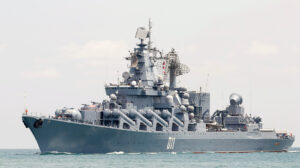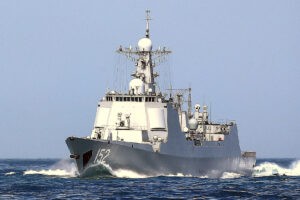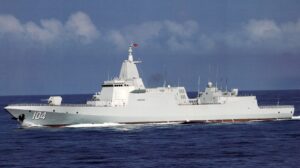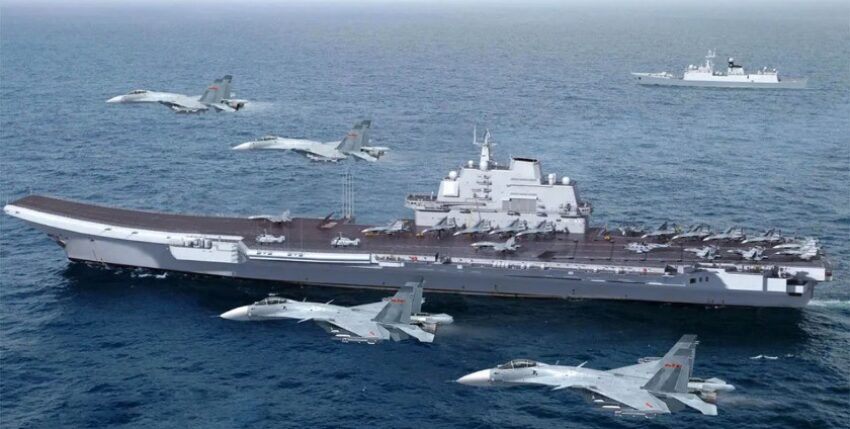[et_pb_section fb_built="1" _builder_version="4.16" global_colors_info="{}"][et_pb_row _builder_version="4.16" background_size="initial" background_position="top_left" background_repeat="repeat" global_colors_info="{}"][et_pb_column type="4_4" _builder_version="4.16" custom_padding="|||" global_colors_info="{}" custom_padding__hover="|||"][et_pb_text _builder_version="4.19.2" background_size="initial" background_position="top_left" background_repeat="repeat" global_colors_info="{}"]Naval movements can be observed between the Chinese mainland and the Philippine Sea that would not have been worth mentioning in normal times. In view of the tense global security situation, they appear in a different light.
"Maritime interaction" between China and Russia
Warships and auxiliary vessels of the navies of the Russian Federation and the People's Republic of China (PRC) will be exercising together in the East China Sea from 21 to 27 December 2022. Actually nothing special since August 2005. Since 2012, the navies of both countries have been practising annually as part of the "Морское взаимодействие" manoeuvre series, which translates as "Maritime Interaction". The Chinese title sounds more modern: "Joint Sea".

The Russian participants in the exercise have been underway since 19 December. They include the flagship of the Pacific Fleet, the Slava-class guided missile cruiser "Varyag", the Udaloy-class frigate "Marshal Shaposhnikov", the Steregushchiy-class corvettes "Sovershennyy" and "Hero of the Russian Federation Aldar Tsydenzhapov" (project 20380/20381).
[/et_pb_text][et_pb_gallery gallery_ids="26314,26313" posts_number="2" _builder_version="4.19.2" _module_preset="default" custom_margin="||-10px||false|false" global_colors_info="{}"][/et_pb_gallery][et_pb_text _builder_version="4.19.2" background_size="initial" background_position="top_left" background_repeat="repeat" custom_margin="-10px||-6px||false|false" global_colors_info="{}"]
According to reports in the South China Morning Post, the Chinese naval units participating in "Joint Sea 22" belong to the Eastern and Northern PLA Commands (People's Liberation Army). The destroyers "Baotou" (newbuilding) and "Jinan" of the Luyang II/III class (Type 052C and 052D), the frigates "Binzhou" and "Yancheng" of the Jiangkai II class (Type 054A), as well as the fleet supply ship "Gaoyou Hu" of the Fuchi class (Type 903A) left their base in Zhoushan/Ningbo (50 kilometres south of Shanghai) on 20 December. In addition to the participation of aircraft and helicopters, an unnamed submarine was also announced.
[/et_pb_text][et_pb_gallery gallery_ids="26322,26315" posts_number="2" _builder_version="4.19.2" _module_preset="default" custom_margin="0px||0px||false|false" global_colors_info="{}"][/et_pb_gallery][et_pb_text _builder_version="4.19.2" background_size="initial" background_position="top_left" background_repeat="repeat" custom_margin="31px||||false|false" global_colors_info="{}"]Chinese carrier group

A Chinese carrier battle group of six units has been in the Philippine Sea since 16 December 2022. The carrier "Liaoning" was operating around 300 nautical miles south of the main Japanese island on 20 December. Its escort includes the two Renhai class newbuilding destroyers "Anshan" and "Wuxi" (type 055, construction numbers 3 and 4), the Lujang III destroyer "Chengdu" (type 052D), the Jiangkai II class frigate "Zhaozhuang" (type 054A) and the fast carrier group supply ship "Hulun Hu" (type 901).
[/et_pb_text][et_pb_gallery gallery_ids="26317,26320" posts_number="2" _builder_version="4.19.2" _module_preset="default" global_colors_info="{}"][/et_pb_gallery][et_pb_text _builder_version="4.19.2" background_size="initial" background_position="top_left" background_repeat="repeat" global_colors_info="{}"]Second carrier support group
According to the Japanese armed forces command, the Renhai class destroyer "Lhasa" (Type 055, construction number 2), the Luyang III class destroyer "Kaifeng" (Type 052D) and the Fuchi-class fleet supply ship "Tai Hu" (Type 903A) had already moved through the Osumi Strait (south of Kyushu Island) into the Western Pacific, while the "Altbau" destroyer "Taizhou" of the Russian Sovremenny class (keel laid in 2002) made its transit through the Miyako Strait (south of Okinawa Island). The day before, a large Shupang-class reconnaissance ship (Type 636A/B) was observed westbound (oncoming) in the Osumi Strait within Japanese territorial waters. On the same day, two Chinese H-6 strategic bombers (TU-16 "Badger") were heading from the Yellow Sea to the sea area of the Japanese islet of Oki-Daito, far southeast of us, and back.
Demonstration of maritime strength?
The Sino-Russian movements confirm the trends of growing maritime self-confidence that have been observed for some time. On the one hand, there are the increasing military relations between the two countries. Joint naval exercises between China and Russia are now routine. Even outside of the "Морское взаимодействие"/Joint Sea manoeuvre, joint actions are taking place, some of which are provocative in nature.
It was not until June 2022 that a Russian group consisting of seven surface units first circumnavigated Japan in a clockwise direction. A five-unit Chinese task force followed about a week later.
An aircraft carrier convoy with the "Liaoning" carried out similar exercises in the region now being practised in May 2022. At that time, it was escorted by seven ships, including the "Chengdu" and "Hulun Hu", which are also accompanying it this time. Over 300 aircraft sorties were recorded during the twenty or so days of the exercise.
Back in October 2021, a joint group of ten (five surface vessels from each nation) used both the Tsugaru Strait in the north and the Osumi Strait in the south of Japan to circumnavigate the Japanese archipelago. Both straits are considered international waters. The passage of the Tsugaru Strait at that time was noted as a first by the Japanese side.
For comparison: In April 1998, the "USS Nimitz" managed around 700 sorties within six days. During Operation Enduring Freedom, 90 sorties a day were standard. The US Navy calculates 120 sorties per day for a Nimitz-class carrier.
Assessment
Ultimately, the simultaneous appearance of the carrier group around the "Liaoning" and the Sino-Russian naval manoeuvre causes a frown.
The navy of the People's Republic of China has developed both in terms of the number and modernity of its warships as well as the capabilities required for naval warfare. Its current appearance shows that it is capable of leading several formations beyond its immediate sphere of influence. The extent to which this allows conclusions to be drawn about its combat capability remains to be seen, as too little is known about its training and material quality. On the other hand, it is capable of engaging opponents over long distances and bringing its weapons to bear. The fact that three Type 055 destroyers operate together with the carrier is remarkable. With their modern command and weapon deployment systems, these units open up new possibilities for practising air defence and controlling long-range airspace.
Sensitive world region
All of this comes at a time when Beijing is more wary of Washington's Indo-Pacific strategy than Moscow. The carrier group around the "USS Nimitz" is just replacing the "USS Ronald Reagan" and begins its routine deployment in the Western Pacific. A US Navy amphibious group around the "USS Makin Island" (LHD 8) practised with the Indonesian Navy as part of the "Indonesia 2022" exercise in the Western Pacific.
At the same time, the new Japanese security strategy was published. Japan is moving away from the principle of pure self-defence and is significantly increasing its defence budget. In any case, the strategically important region in the Philippine Sea south of Japan and east of the island of Taiwan is prone to animosities. The nuclear submarine agreement concluded last month between the USA, Great Britain and Australia was received with caution and criticism by some neighbours.
[/et_pb_text][/et_pb_column][/et_pb_row][/et_pb_section]










